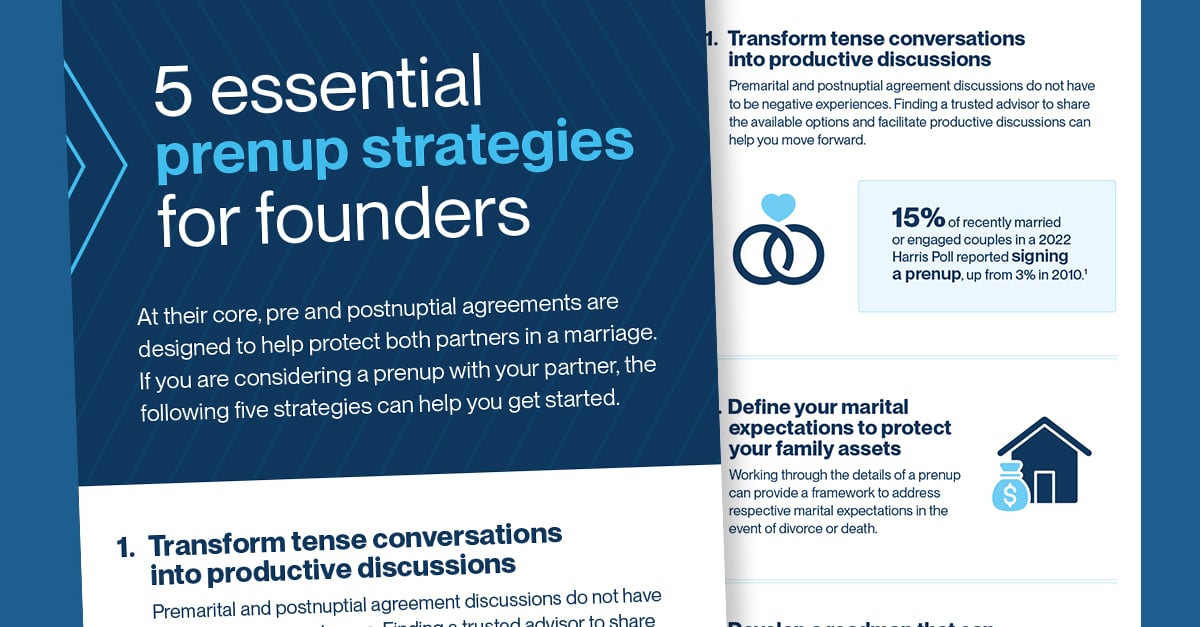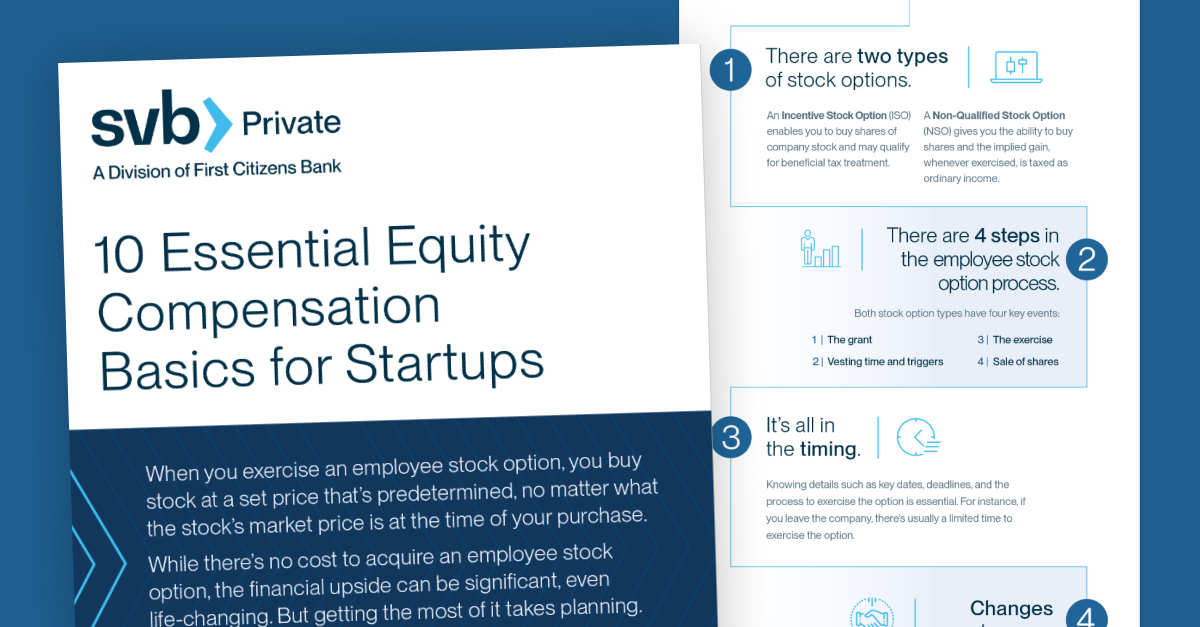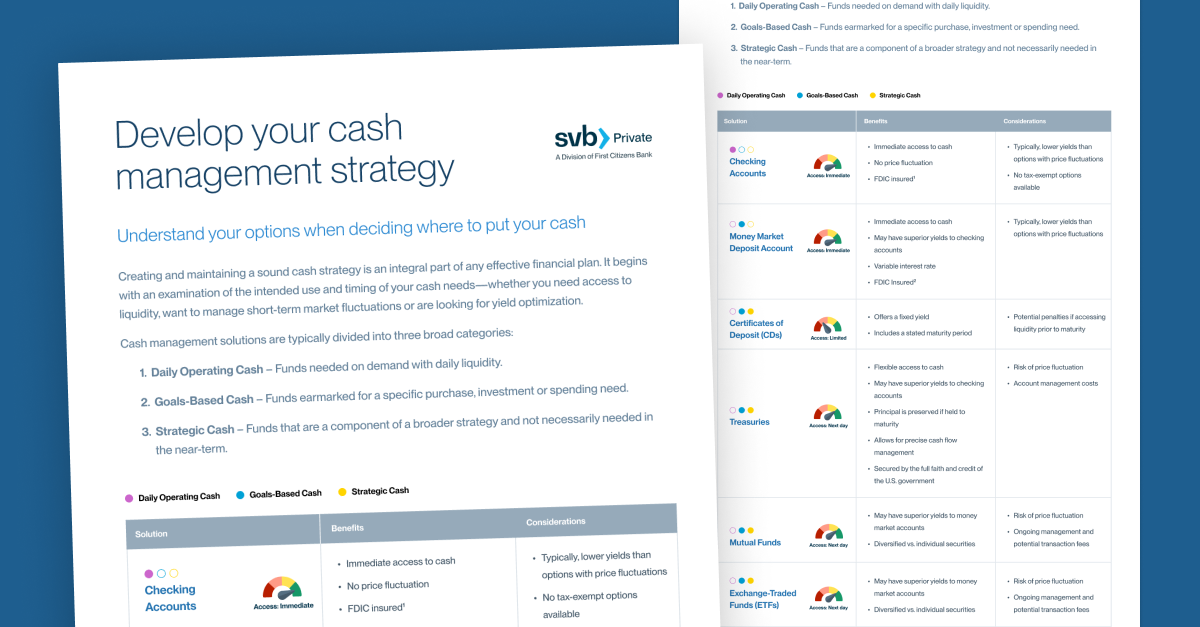We’re pleased to provide you with insights like these from Boston Private. Boston Private is now an SVB company. Together we’re well positioned to offer you the service, understanding, guidance and solutions to help you discover opportunities and build wealth – now and in the future.
Kathleen Kenealy, Director of Financial Planning, provides insight on when, how and the appropriate investment considerations when saving for college costs. Listen now to her discussion with Jason Cain, Head of the Center for Wealth Planning Excellence.
Transcript
Jason: Hello. And welcome to Boston Private Perspectives. I'm Jason Cain, head of the Center for Wealth Planning Excellence. As part of our continued commitment to keeping our clients informed on current events and the potential impact on your wealth and financial goals, I'm sitting down with Kathleen Kenealy, the head of our Financial Planning Group here at Boston Private, to discuss college savings, planning, and considerations. Hello, Kathleen. How are you doing today?
Kathleen: I'm good, Jason. How are you today?
Jason: Doing well, thank you. A hot topic given this time of year, and one with a lot of question marks given where we are in the COVID-19 battle. But I thought it'd be very beneficial for us to talk a little bit about college savings.
Kathleen: Yeah, it's a great topic, one that comes up pretty frequently with clients who have kids and even grandkids that hopefully someday will go to college. And they want to know what the right way to go about saving and planning for those costs are going to be.
Jason: And you hit something right on the head that I think we should jump into off the get-go here, is cost. Let's talk a little bit about what it costs to send somebody to college here in 2020. And then also what we expect that to be maybe 10, 15 years from now when our clients with young children are getting their children ready. So let's kick it off with a dialogue on cost. What are you seeing in the marketplace for the cost to educate at the college level?
Kathleen: So the College Board put out a report last year in 2019, called Trends in College Pricing, and that that report found that the average published tuition and fees at a private not-for-profit four-year institution was $36,880 for the 2019/2020 school year. And keep in mind that that's just tuition and fees. So once you add in room and board, that total average costs rise to just shy of $50,000 a year. And then if you tack on another $4,100, for books and supplies, and transportation costs, and other miscellaneous expenses that come up, that brings you close to about $54,000 a year, and that's an average cost. So of course, there are going to be some schools that are a lot higher, and some schools that are going to be a lot lower.
The schools that they look at aren't just private four-year institutions, but they look at all types of institutions. So for comparison purposes, a four-year public in-state tuition is about $10,400 a year for tuition and fees, approximately $11,000 a year for room and board, and another call it $5,000 for books and supplies and miscellaneous expenses. So for public in-state tuition, you're looking at a much lower cost of about $26,000, $27,000 a year.
Jason: So those numbers, I'm assuming the $55,000 a year, let's call it for private and then the $27,000 or so for public, those are actual costs. I know that many universities have stated costs above that number, kind of the off-direct costs. But that incorporates aid in scholarship money. And those are kind of the average pay for each child that goes. Is that correct?
Kathleen: So those are the, like, actual published costs for the schools. Again, it's an average. So it doesn't necessarily include aid or scholarships or grants that you might get.
Jason: Got it. Got it.
Kathleen: Yeah, so that is quite likely that people will get some form of aid or whether it's through grants or need-based scholarships, or merit-based scholarships, that will bring that number down.
Jason: And those numbers are for 2020. They aren't for 2021. They're the cost of education here in 2020. So if we look at private schools, four years at that number is $225,000 before inflationary costs. If we look at public, we're a little bit north of $100,000 a year for four years. What's the trend been for increase in those costs as we look forward?
Kathleen: So the same report found that over the last decade, tuition and fees rose around 2% a year over based inflation. So, you're looking at probably a 4% to a 5% annual increase over the last 10 years. But if you go back even further, the same College Board report tells us that tuition and fees in the public four-year sector are actually almost three times as high as they were 30 years ago. And that's after for adjusting for inflation.
So if rising college costs, continue to outpace inflation going forward, in the planning work that we do with our clients, we do assume that that's a trend that is going to continue that that makes an argument for needing to set aside even more than you think might be necessary to compensate for those increased costs over time.
Jason: So if I do some back-of-the-envelope math, and I have a college freshman that's going to a private school here in 2020. Four years of tuition with the increase over the next three years, I'm looking at probably close to $250,000. And if he's going to or she's going to a public university in-state, probably looking at close to $125,000. That's a lot of money. And I guess that leads me to my next question for you. How do we save for it? How do we get our clients comfortable with starting to build a nest egg for their young children to get to those numbers?
Kathleen: Yeah, that's a good question. And I actually ran the math on these two to kind of give you a sense of how those numbers can change depending upon, for example, how old your child is, and how many years you have to go until they enter college and the number of years that you have to save.
So say, for example, you have a newborn, and you've got 18 years during which you can start saving for college. If we then assume that college costs, as I mentioned before, rise at about 5% a year, that we are going to earn some return on the money we saved, say about 6.5%, you'd actually need to set aside about $11,500 a year, or just under $1,000 per month in a 529 college savings account, if you wanted to be able to fully fund four years of private undergrad at about $54,000 a year.
But alternatively, if you wanted to only cover four years of, say $27,000 a year, you'd only need to save about $475 a month if you have 18 years over which to save. But I know that not everybody opens up their 529 plan the day their son or daughter is born. So if you actually wait until your child is eight, and now they've got only 10 years to go until they enter college, you'd have to dramatically increase that savings rate. So instead of saving about $1,000 a month, you'd have to bump that up to about $1600 per month to pay for that same private 4-year education. But if they're going to potentially go to an in-state school, you need to bump it up from about $475 a month to about $800 a month.
So I thought it would be helpful to put some context around what the actual monthly savings rate would have to be if wanted to cover those costs by the time your child enters college.
Jason: I think that is incredibly valuable information to have as kind of a bogey to start with when you have children. And I think you hit it right on the head. Not everybody starts the day after they're born. Ideally, that would give you the most flexible funding structure to get to these very large costs. And the other aspect of this too is not everybody pays for all of the college costs. There are merit-based scholarships. There are a whole host of other scholarships, need-based scholarships that come into play.
I think I've heard you talk about safety and having a good solid starting point as a critical component of financial planning, so it helps us to build out a plan. You talked...you mentioned 529 savings accounts. Can you... And that's really about how you save versus what you say. Can you tell me a little bit about some of the rules and regulations around 529 accounts and what are they, specifically? Because that seems to be a real important component of college savings is these special types of accounts. Can you share with our audience what those are and how they work?
Kathleen: Yeah. So a 529 college savings account is a type of account that you can open for your child or grandchild, or pretty much technically anybody, that allows you to save in a tax-advantaged manner for college. And I should also clarify that by saying, when the Tax Cuts and Job Act went into effect in 2017, they made a couple changes to what you can use 529 plans for. And you can now actually use a little bit of 529 plan money each year towards secondary education. It doesn't have to be college or graduate school.
But basically, the way a 529 plan works is when you put money into a 529 plan, it grows tax-free until you start taking money out for college. And then if you take a withdrawal that's used for qualified higher education costs, the money comes out tax-free as well, which is pretty great. And if, for example, you end up, not using the 529 money, and you take out a withdrawal to pay for something that is not a qualified higher education cost, you do pay income taxes on the growth as well as a 10% penalty. But for most people, they are able to use 529 college savings plans as a really great way to save for college.
And I think, one of the nice things about it as well is that if, for example, you have a 529 plan for your older child, and they end up not needing all of those funds to go to school, you can actually change the beneficiary on the 529 plan to a sibling, or there's actually a broader pool of people that qualify that you can change the beneficiary to. You can actually also use it for yourself. If your kids get through school, and then you decide you want to go back to school yourself or go back to grad school, those funds are available for you as well. So there's a lot of benefits to them.
Jason: Sorry to interrupt. You mentioned grad school. What if your child doesn't use it all for undergrad and they have some leftover? You can use that for say, medical school, law school, graduate school, is that correct?
Kathleen: Yeah, that's correct. Yeah.
Jason: It's not just for undergraduate use? It could be for graduate school use also?
Kathleen: Yeah. Yes, it can.
Jason: So another question. What can you use it for? Can you use it for room and board? Can you use it for... It sounds like for tuition. What about some of the other ancillary expenses associated with college, computer books, maybe even travel? Can you give us a little bit of an insight into what those dollars can be used for?
Kathleen: Yeah, I think you hit most of the big ones already. So definitely tuition and fees, room and board, book. I think even, like, if you buy a computer that you need for school. There's a pretty long list of qualified expenses that you can use it for. So it does give you a pretty good range of flexible options that you can spend the money on, which is great.
Jason: So the benefit is income-tax-free growth while the assets are being saved inside the account. If you use them for college expenses, they come out income-tax-free. So it's like an IRA on steroids for college savings. And there... Tell me, I've heard about other state income tax benefits to some of these. Can you share with me what those are?
Kathleen: Yeah, so with 529 plans, each state actually has its own 529 plan or sort of sponsors a 529 plan. And so, I think one of the things is there's this idea that you have to live in a certain state in order to participate in that state's 529 plan. But that's actually not correct. You can participate in any 529 plan that you want. But you always want to start by looking at your state to see if there are any state advantages for participating in your state's 529 plan. Because some states do offer an income tax deduction on your state income tax return.
So here in Massachusetts, for example, if you contribute to the Massachusetts 529 College Savings Plan, you get a Massachusetts State income tax deduction when you file a return of up to $1,000 if you're a single filer and up to $2,000 if you are married, filing jointly. And so, every state is different. Every state has its own rules. But it's always a good place to start when you are looking for which 529 plan you're interested in using.
One of the places I look to for information when I'm trying to figure out what my client’s state's plan offers, is a website called savingforcollege.com, which actually lets you look up each individual state's plan to see if there's an income tax deduction or another benefit for being a resident of that state and using their 529 plan.
Jason: Yeah. So it sounds like it there are significant state benefits in your residence state if you happen to use that plan. But to your point, you don't have to use that plan. And if you find that you don't like the investment options in a certain plan, can you switch plans, go to a different state-sponsored plan?
Kathleen: Yes, you can. Yeah. And as I said, not every state offers income tax benefits. Some of them do, some of them don't. So it's important to kind of check each plan. But if you start off with one plan, and you want to make a change, you can, I believe the limitation is just, you're allowed once per year to make a change.
Jason: Got it. Kathleen, are there any limitations on how much you can contribute to 529 plans?
Kathleen: Yes, there are. And there are a couple of different limitations that apply here. So one is the limitation that the state actually puts on its own 529 plan. So, some states may have a maximum funding amount of $250,000 or $200,000 or $300,000 as a state-directed maximum contribution amount. So that's one thing that should be taken into consideration.
Other than does that maximum amount that the state says, I won't call it a maximum funding amount, but I think there are some other considerations you need to think about. So one is that if you are a parent, and you set up a 529 plan for your child, you're the owner of the account, that the child is the beneficiary. And so any money that you put into the 529 plan actually counts as a gift. So you do have the annual gift exclusion that you can use.
So say, for example, you can put $15,000 into a 529 plan this calendar year, and that will use up your annual gift amount for your child. If you are married, you can put $30,000 into the plan for your child and still stay within the exemption limit. There's actually a rule where you can actually fund up to five years of annual gifts all in one year. So if you've got some lottery winnings lying around and you just want to throw a bunch of cash into a 529 plan, you can do 5 years of $15,000 a year into the 529 plan, or even double that if you're married filing jointly.
The sort of caveat is that you have to survive those five years, otherwise, there's some estate tax implications there. And you're also prevented from making any additional gifts to your kid over that same five years. So you kind of need to let the clock run out before you do any additional gifting.
Jason: Fantastic. Now, the 529 plan isn't the only tool that families we work with use for savings. Can you share with me what other clients that you've worked with use? What other types of savings mechanisms do they use for college?
Kathleen: Yeah. I mean, I think one of the things people do also look at but they're not quite as common are prepaid 529 plans. So this allows you to sort of prepay future college costs. Today, there are, I want to say maybe, like, 15, or 20 states that sponsor them. But they are an option, they're not quite as commonly used. Some people they just save in a normal savings account or a normal investment account, which you can certainly do. But I would say that because that doesn't give you the tax-free growth that a 529 plan does, you're ultimately going to have to save a little bit more in a non-tax preferential vehicle to make up for the tax savings difference.
And then I've also seen some people use educational trusts, or use UTMA accounts to put aside some money for kids, whether it's the parents themselves or very commonly, grandparents might set up a trust or an account for their grandchild to help their children and grandchildren save for college as well. So there's a lot of different ways to save. I love 529 plans. I think they're great if you are really looking to save specifically for undergrad or graduate school costs.
But if you, for example, want to have some flexibility for how the kid uses the funds at some point in the future without paying any penalties, then perhaps, maybe there's a different vehicle that might be better suited.
Jason: Yeah. It sounds like the tax avoidance of the accumulation inside the 529 account and the potential state income tax benefit that you get when you contribute to it, for a vast majority of folks, the 529 is likely the vehicle of choice. It sounds like there's also a number of different options, that prepay one. Except if you have the dollar sitting there and want to avoid the inflationary increase in costs of college tuition that you could capture the price now for a child that might not go to school for 15 years. There's obviously some drawbacks there
But from a general perspective, you would head with the 529 for a vast majority of folks? That's what it sounds like you're saying. I just want to make sure that's what makes the most sense for most folks.
Kathleen: Yeah, I think that does make the most sense for the majority of people. But like I said, every situation is different, and every family circumstance is a little different. And there are always some nuances that might make something else more appropriate. But generally, I would say 529 plans are a great way to get started.
Jason: And as I've heard you say time and time again, it might be the best vehicle generally, but the key is sitting down and having a dialogue about what you're trying to accomplish and how you're trying to accomplish that. That interactive financial planning and fitting everything into your unique, a client's unique set of circumstances is really the key at the end of the day.
Kathleen: Yeah, it really is. What vehicle you use, and also how much you are setting aside each year for college really should be a decision that you make in the context of your broader, full financial picture. And I think for a lot of people, they're trying to balance the tradeoff between meeting current lifestyle expenses and needs and saving for college, but then also saving for retirement. And as I tell a lot of my clients, you can borrow for college, but you can't borrow for retirement.
And the metaphor I usually like to use here too is that if you're flying on an airplane with your kids and you go through the safety instructions before you take off, they always tell you to put your own oxygen mask on first before you help anyone else. And I think that same idea really does apply here. You want to make sure you as the parent are taking care of yourself and your future before you start sacrificing your retirement savings just to make sure you can pay a full $54,000 a year for four years.
Unless, you have that conversation with your child, and they're comfortable and you're comfortable with the possibility that, they might need to be supporting you in your golden years because you put them through really expensive, private four-year education.
Jason: Certainly, a dialogue that needs to occur with professional advisors, because it's not an easy decision to make. And I love the analogy that you use with regard to the face masks. I think that hits it right in the sweet spot. Now, one last question that I have. And I've seen this with families where grandparents want to help you. Tell me about the rules around...we talked a little bit about gifting limitations. But what happens when grandma and grandpa or even aunts and uncles pay tuition directly to the university. I've heard that there's some tax incentives there. Can you tell me a little bit about how that's used in the overall, for me?
Kathleen: Yeah, so we talked about the annual gift exclusion amount of $15,000 a year. But there's actually a couple of things that you can do in order to help other people out with payments that don't actually count against that annual gift exclusion amount. So if you pay tuition directly to the school, so you write a check out to Harvard University instead of your...you don't make the checkout to your child or grandchild and have them turn around and give that check to Harvard. If you pay the tuition directly to the school, it's not considered a gift. So it doesn't count against that annual gift exclusion amount and it doesn't reduce your lifetime exemption amount either.
So it's a pretty gift and estate tax efficient way to help somebody out with college costs while also, at the same time if having a taxable estate at the time of your death is an issue for you, it's a great way to draw down on your estate while helping out your kids and your grandkids, financially speaking. So and that same rule applies to medical costs too. So tuition and medical costs are the big things. If you need to write a check to a hospital, for some reason, that also counts in those rules.
Jason: And I think you hit it right on the head that in the instance, say grandma or grandpa are paying for the grandchildren's tuition. They can't write the check to mom and dad. They can't write the check for the kids. They have to literally cut the check directly to the academic institution.
Kathleen: That's correct.
Jason: Fantastic. Well, thank you, Kathleen, for walking us through these issues. The thing I heard loud and clear is communication, to have a plan, to work with a professional to put it together. And we appreciate getting your insight with regard to everything there. I know we've covered a lot today. And while there's always uncertainty, we want to encourage all of our clients to reach out to Kathleen and her team at Boston Private with any questions or ongoing concerns that you might have.














